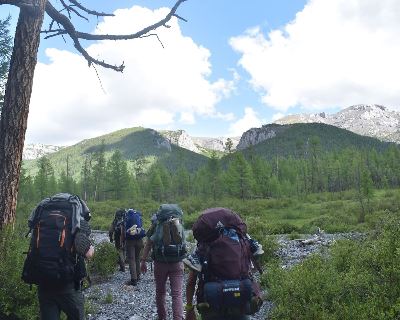A Day in the Darhad Valley of Northern Mongolia
Noelle Foster, summer 2023 zoology graduate
December 7th, 2023
 I wake up in the early morning to the sound of yaks grazing outside of my tent, a mixture of many grunts and chewing sounds. This still feels so surreal, I have made it to Mongolia! I unzip my sleeping bag and emerge from my tent to take in the beautiful dew covered view of our home for the next 7ish weeks at basecamp. It is beautiful.
I wake up in the early morning to the sound of yaks grazing outside of my tent, a mixture of many grunts and chewing sounds. This still feels so surreal, I have made it to Mongolia! I unzip my sleeping bag and emerge from my tent to take in the beautiful dew covered view of our home for the next 7ish weeks at basecamp. It is beautiful.
Right outside of our basecamp is a marsh meadow dominated by birch and willow species surrounded by the backdrop of the Horidol-Sardag Mountain Range. Three planes rides, one overnight train ride and an impressively bumpy furgon (an off-road 4x4 van) ride, and this view alone is every bit worth the long journey to get here. The sight of smoke coming out of the kitchen ger (a traditional Mongolian dwelling that is easily portable for a nomadic lifestyle but can also withstand the harsh Mongolian winters) means breakfast is almost ready.
I head into the ger and see our cook, Amkaa, prepping breakfast. Amkaa is the best and cooked most all of our meals for us throughout our time in the Darhad. She even traveled on horse to cook for us on one of our backpacking trips. With the smell of freshly cooked breakfast wafting through basecamp, everyone slowly crawls out of their tents and gathers at our picnic table to eat. For breakfast, we have freshly delivered yak yogurt, Muesli, pancakes, and fried eggs. It’s a feast and my favorite part of the day. This is the calm before the storm.
After breakfast, we are hiking 20 miles round trip with significant elevation gain to collect camera trap SIM cards from ‘the Notch,’ which is one of the higher points in the Horidol-Sardag and offers excellent views of the Valley. Camera trap distribution and collection helps understand presence and detection frequency of animals in the Ulaan Taiga Special Protected Areas, which is where we were are located. This data along with all of our projects final data (Daurian Pika decline analysis, Great Cormorant abundance and diet study, and Vansemberuu population studies), will be written in a scientific paper and submitted to the Mongolian government for direct use in conservation planning for the area.
The trip to The Notch is not easy, but it is made easier by snacking on apricots and peanut butter, singing, and playing word games. Once we reach the top, we are taken aback. We knew the views would be gorgeous, but it is nothing like we have ever seen before. Monstrous, jagged mountains cutting through the clouds so high that we have to crane our necks to even see the tops. Looking down, we can see the entire valley a thousand and more feet below us. It’s lush with trees and the Mongash River snakes through it all. I don’t think there was a dry eye between the eight of us (6 students and 2 amazing instructors).
This view and many more of the amazing experiences I experienced in Mongolia would not be possible without Weber State Universities Hulet Scholarship, funded by Elliot Hulet, and the College of Science Undergraduate Research Fund. I was able to go on this trip with Round River Conservation Studies, fully funded by Weber State University and Elliot Hulet. I will forever be grateful. I am also grateful for the Mongolian people, who welcomed us with open arms into their homes and land. A main reason I am writing this blog is to raise awareness that is it possible for any Weber State student, regardless of their economic stance, to go on a study abroad trip like this and assist in conservation research with Round River.
I must make a note, it was hard to choose which ‘day in the life’ to write about because truly every day was different. One day we would be on a backpacking trip measuring Vansemberuu (a culturally significant medicinal plant species that is critically endangered) plots 2,000 feet up on unsteady talus fields, and the next we would be swimming out to a great cormorant breeding colony to plant camera traps and conduct a population survey.




Author:
Noelle Foster came to Weber State from Eagle, Idaho to play softball for the school’s program. She chose Weber because she has a strong passion for wildlife conservation and knew she wanted to major in zoology. With the nine credit hours received from her time in Mongolia, Noelle was able to graduate summer 2023 with a bachelor degree in zoology and a minor in botany.
Contact:
Ali Miller, College of Science
marketing and communications manager
amiller@weber.edu